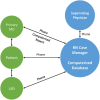Retrospective Analysis and Forecasted Economic Impact of a Virtual Cardiac Rehabilitation Program in a Third-Party Payer Environment
- PMID: 34901923
- PMCID: PMC8653769
- DOI: 10.3389/fdgth.2021.678009
Retrospective Analysis and Forecasted Economic Impact of a Virtual Cardiac Rehabilitation Program in a Third-Party Payer Environment
Abstract
Background: Participation in cardiac rehabilitation (CR) is recommended for all patients with coronary artery disease (CAD) following hospitalization for acute coronary syndrome or stenting. Yet, few patients participate due to the inconvenience and high cost of attending a facility-based program, factors which have been magnified during the ongoing COVID pandemic. Based on a retrospective analysis of CR utilization and cost in a third-party payer environment, we forecasted the potential clinical and economic benefits of delivering a home-based, virtual CR program, with the goal of guiding future implementation efforts to expand CR access. Methods: We performed a retrospective cohort study using insurance claims data from a large, third-party payer in the state of Pennsylvania. Primary diagnostic and procedural codes were used to identify patients admitted for CAD between October 1, 2016, and September 30, 2018. Rates of enrollment in facility-based CR, as well as all-cause and cardiovascular hospital readmission and associated costs, were calculated during the 12-months following discharge. Results: Only 37% of the 7,264 identified eligible insured patients enrolled in a facility-based CR program within 12 months, incurring a mean delivery cost of $2,922 per participating patient. The 12-month all-cause readmission rate among these patients was 24%, compared to 31% among patients who did not participate in CR. Furthermore, among those readmitted, CR patients were readmitted less frequently than non-CR patients within this time period. The average per-patient cost from hospital readmissions was $30,814 per annum. Based on these trends, we forecasted that adoption of virtual CR among patients who previously declined CR would result in an annual cost savings between $1 and $9 million in the third-party healthcare system from a combination of increased overall CR enrollment and fewer hospital readmissions among new HBCR participants. Conclusions: Among insured patients eligible for CR in a third-party payer environment, implementation of a home-based virtual CR program is forecasted to yield significant cost savings through a combination of increased CR participation and a consequent reduction in downstream healthcare utilization.
Keywords: cardiac rehabilitation; coronary artery disease; economic impact; mobile health; virtual care.
Copyright © 2021 Harzand, Weidman, Rayl, Adesanya, Holmstrand, Fitzpatrick, Vathsangam and Murali.
Conflict of interest statement
AH, AA, and HV report ownership interest in Moving Analytics. AA and HV are senior officers and receive salary support from Moving Analytics. The remaining authors declare that the research was conducted in the absence of any commercial or financial relationships that could be construed as a potential conflict of interest.
Figures
References
-
- Thomas RJ, King M, Lui K, Oldridge N, Piña IL, Spertus J, et al. . AACVPR/ACC/AHA 2007 performance measures on cardiac rehabilitation for referral to and delivery of cardiac rehabilitation/secondary prevention services. Circulation. (2007) 116:1611–42. 10.1161/CIRCULATIONAHA.107.185734 - DOI - PubMed
-
- Harzand A, Witbrodt B, Davis-Watts ML, Alrohaibani A, Goese D, Wenger NK, et al. . Feasibility of a smartphone-enabled cardiac rehabilitation program in male veterans with previous clinical evidence of coronary heart disease. Am J Cardiol. (2018) 122:1471–76. 10.1016/j.amjcard.2018.07.028 - DOI - PMC - PubMed
LinkOut - more resources
Full Text Sources
Miscellaneous




